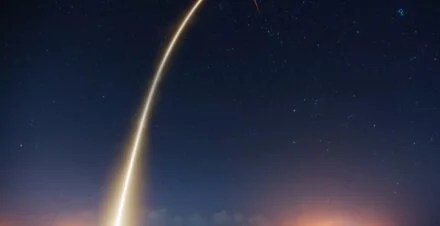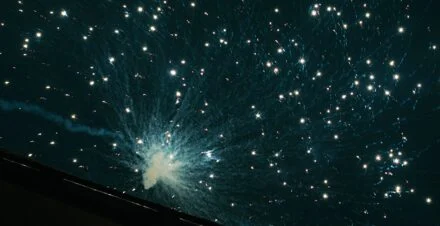By now we’ve all heard the news that none of us wanted to hear — a significant breakup occurred in space, and was intentionally performed by Russia via direct-ascent anti-satellite (DA-ASAT) missile strike against one of their own defunct satellites. LeoLabs unequivocally condemns this irresponsible act that now harms all spacefaring nations and the entire space economy for years to come.
Frustrated as we all are, we now must turn to the aftermath to start understanding the ramifications of this event on the low Earth orbit (LEO) operating environment. This post will share preliminary data from LeoLabs collected so far on newly tracked debris, along with insights and predictions based on decades of research and conclusions drawn from past similar events.
At the time of this writing, it’s been three days since the breakup of the Cosmos 1408 satellite. The debris created from the fragmentation of Cosmos 1408 has not been fully cataloged or characterized yet, and will likely not be for some time. However, from early measurements and a knowledge of previous relevant breakup events, several observations can be made. It should be noted that much of the information required to re-create accurate simulations of this event will likely never be available, so the community will have to rely on empirical observations of the fragments and “rules of thumb” developed analyzing past similar events. One thing is for certain:
There will be some potential collision risk to most satellites in LEO from the fragmentation of Cosmos 1408 over the next few years to decades.
The first question we’re all wondering is…how many new pieces of space debris resulted from this new event, and where are they? We can start by examining the extent of previous highly energetic collision events in LEO, namely the Iridium 33 / Cosmos 2251 collision of 2009 and Chinese ASAT destruction of Fengyun 1C in 2007. Then we can compare this to early information gathered on newly detected objects to glean some insights.
Cosmos 1408 — Before the ASAT Test
First, some observations about Cosmos 1408 and its orbit. While any ASAT test is a terrible idea, this one occurred in one of the worst possible orbits. This satellite was in a high inclination orbit, at an altitude that put it right in the middle of many other operational assets; notably, it was less than 100km above the International Space Station, and less than 100km below multiple commercial constellations including SpaceX’s Starlink fleet.
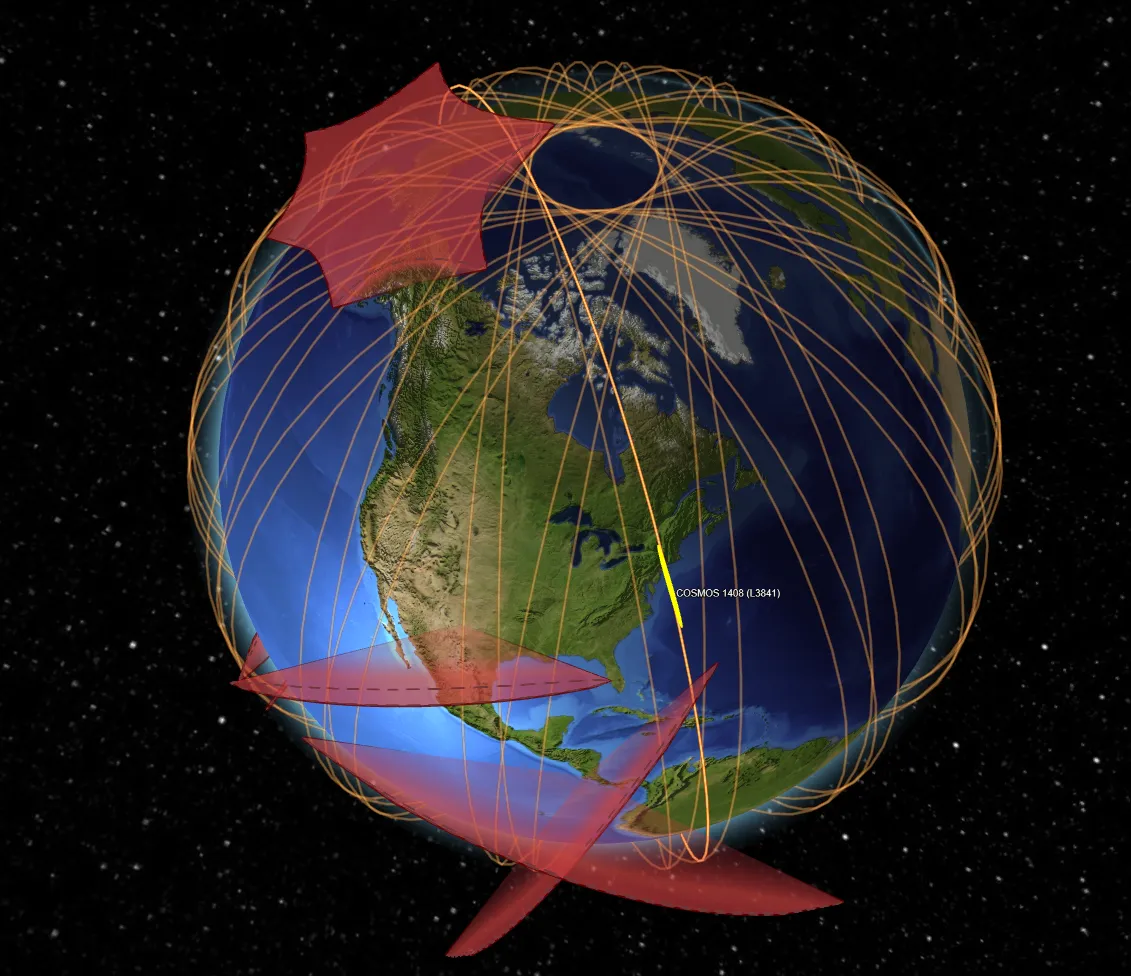
Orbit path of Cosmos 1408 satellite prior to breakup
Cosmos 1408 was also a very large satellite, with a reported mass of ~2,200 kg. LeoLabs reported radar cross-section (RCS) was 8.63 meters squared.
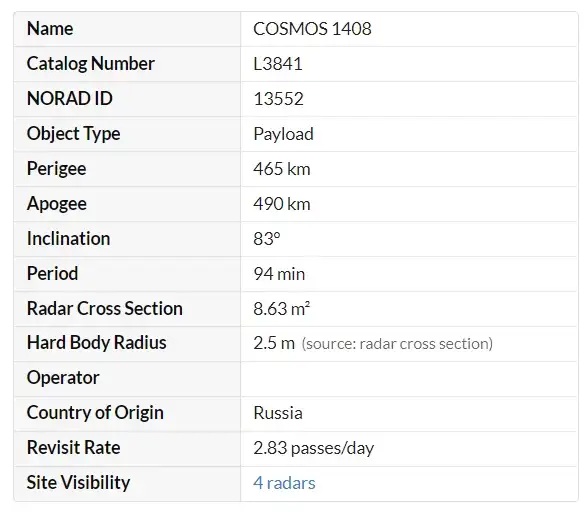
LeoLabs high level information on Cosmos 1408
The Day of the ASAT Test
As LeoLabs is first and foremost a space safety company, this breakup was an “all hands on deck” event for us. Upon first hearing the reports of a possible ASAT test on the morning of November 15, we immediately began checking our data on Cosmos 1408. We saw that we had been regularly tracking this satellite roughly three times per day without issue.
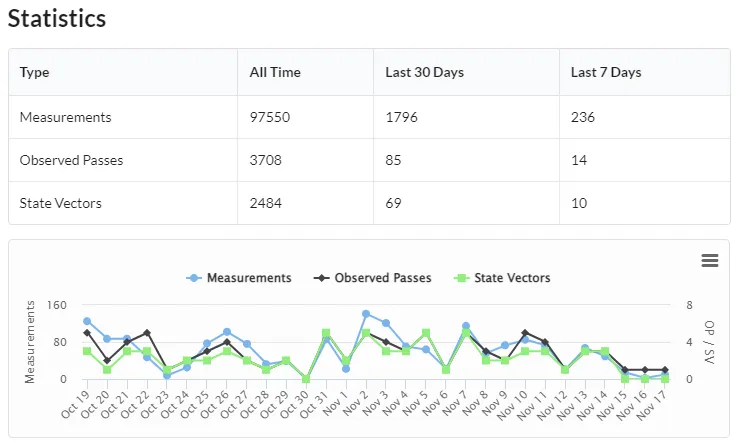
LeoLabs tracking data on Cosmos 1408 for 30 days prior to the breakup event
Over the past 30 days prior to the ASAT impact, we had collected 1,796 radar measurements and generated 69 state vectors with position uncertainties regularly under 100 meters. In short — the Cosmos 1408 satellite was well tracked by our system prior to this event.
As we checked our tracking data for Cosmos 1408 on the morning the ASAT test was reported to have occurred, we noted that our last few planned tracking passes did not return expected data. This was a troubling sign that indicated something was off-nominal, but we needed additional information to confirm. So we tasked Cosmos 1408 to the highest level of prioritization on our space radar network, and scheduled extended observation windows on the next pass to collect additional information.
The next pass occurred at 16:20 UTC, at our Kiwi Space Radar in New Zealand. Our Data Science team was standing by as the data rolled in, and upon review, we quickly noted a “multiple headcount” scenario; that is, we detected multiple individual objects where we would nominally only expect one object. This was a clear confirmation from us that a breakup had occurred, sadly supporting the reports of the successful ASAT test.
Subsequent radar passes over the next two days increased the number of detected fragments significantly. As of this writing, we’ve detected nearly 300 unique fragments and continue to analyze the data.
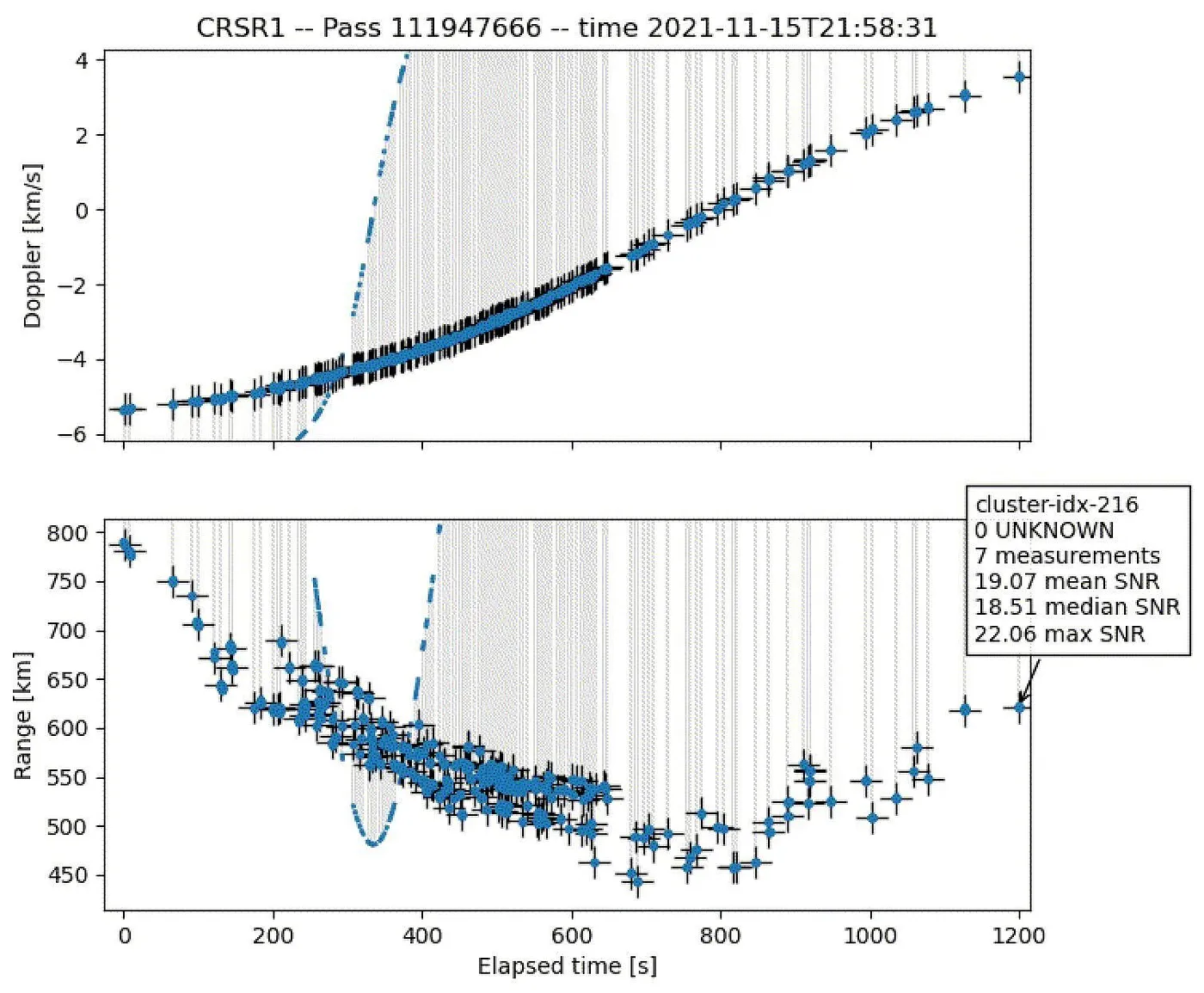
LeoLabs data collected on new Cosmos 1408 debris taken from Costa Rica Space Radar
Within a day of the Russian ASAT test, the 18th Space Control Squadron notified the general public that they had initially detected around 1500 possible associated objects from this impact.
Initial Data Assessment
An initial look at the orbits of some of the new fragments is shown in the Gabbard diagram below. A Gabbard diagram plots the apogee and perigee of breakup fragments against each of the fragments’ orbital period. They are a convenient way to get a quick visual representation of the “landscape” of space fragmentation events, and have been used for decades in the space industry to analyze such events.
Here, blue dots denote the apogee while the “partner” orange dots denote perigee for the same object. The apogee / perigee points for one sample object have been circled in red for ease of interpretation.
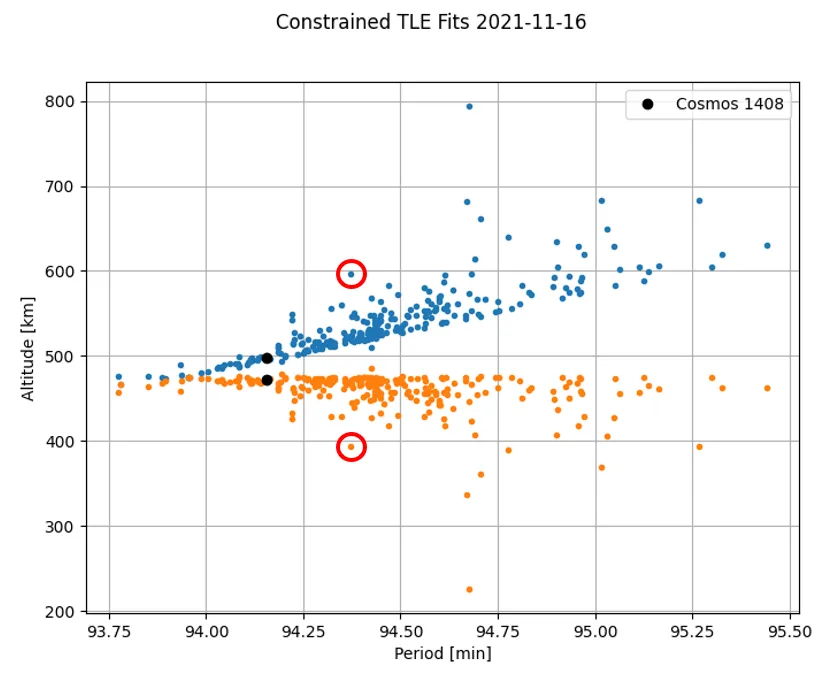
Gabbard diagram of LeoLabs data on 253 new Cosmos 1408 debris objects
This Gabbard diagram shows 253 objects whose orbits have already been preliminarily characterized by LeoLabs (as of 17 November 2021). These data are being refined as our global network of radars provide more detail of the new objects.
Our initial assessment is that these 253 objects likely represent the largest fragments with the least amount of delta velocity imparted to them, as they are orbiting closest to the original orbit of Cosmos 1408. If this is accurate, rules of thumb would indicate 5–10x more objects than this, putting total notional trackable debris counts in the area of 1,250–2,500 pieces.
Given the precarious altitude where this event occurred, the Gabbard diagram provides us with two key takeaways for this event:
- Objects ejected into lower perigees will have their orbits circularize relatively quickly, and the majority will re-enter the atmosphere over the next five years.
- Objects ejected into higher orbits will have their orbits circularize more slowly, and the majority will re-enter the atmosphere over much longer timeframes — potentially decades, depending on altitude.
The collision risk from this resulting debris in the short-term is largely dependent on the orientation of an object’s orbit and the expanding cloud of debris. However, within weeks to months of the breakup, the debris will largely be dispersed around the Earth (i.e., global spread of the fragments’ right ascension of the ascending node). Thus, ultimately the statistical collision risk to other LEO satellites will then be predominantly dependent on altitude.
New Spatial Density of Space Debris
While the Gabbard diagram does a good job of showing the range of altitudes generally affected by this event, the spatial density of resident space objects (RSOs) provides a better way to depict and quantify the statistical collision risk. Statistical collision risk is proportional to the spatial density of the RSO population at that altitude.
The plot below shows our best estimate at the new, current debris distribution. The black spatial density curve provides the number of RSOs per volume as a function of altitude before the breakup of Cosmos 1408. The red line depicts the likely new spatial density values immediately after the breakup event due only to these new fragments.

LeoLabs assessment of the new debris density from Cosmos 1408 breakup
The red line is calculated by taking the preliminary LeoLabs observation data on 253 objects and extrapolating it to corresponding levels for assuming a notional scenario of 1,500 new fragments.
This depiction will be updated as objects become cataloged and exact orbital elements and exact number of fragments are determined. However, since we have seen the evolution of other major breakup events in the past, the trends depicted are helpful in providing a general assessment of the deleterious effects for the LEO regime.
Importantly, this new debris distribution will evolve over the next few years in line with the above observations. Thus, the left half of the red line will diminish more rapidly while the right half of the red line will diminish much more slowly.
Factors Affecting Lifetime in Orbit
The exact longevity of each new debris object will depend greatly on the area and mass properties (usually combined into an area-to-mass ratio), object altitude, and even the construction materials of the objects. The Cosmos 2251 and Iridium-33 collision event at ~788km in 2009 highlighted this difference. For that event, consider the following:
- The majority of the fragments created from the Iridium 33 satellite have decayed over the past 12 years, largely due to the lower material density from it being made much more recently.
- The majority of the fragments created from the Cosmos 2251 satellite are still in orbit, largely due to their Cold War construction — very similar to the lineage of Cosmos 1408 being built “last century”.
When the Chinese catastrophically destroyed their Fengyun 1C satellite in another ASAT test in 2007, that 950 kg satellite generated over 3,000 trackable debris fragments. This equates to over three fragments per kilogram of mass in the target. On the other hand, Cosmos 1408 was a 2,200 kg satellite, yet the current fragment count preliminarily reported by the 18th Space Control Squadron is ~1,500. Taking this number at face value, if correct, would actually represent a better than expected outcome by comparison for the current event. Using the same ratio of fragments generated per mass for the Fengyun 1C event, this would result in a total of ~8,000 new fragments for Cosmos 1408. (Let’s all hope that’s not the case.)
If it is indeed closer to 1,500 trackable fragments, this would be more consistent with the debris generated from the Iridium 33 collision. That event has been highly speculated as not having been a complete fragmentation event (i.e., there were significant parts of the spacecraft that remained intact after the collision with Cosmos 2251). The number of cataloged debris objects was equal roughly to the mass of the satellite (i.e., one cataloged fragment per kilogram of the target).
Unfortunately, the downside to this observation is that there are likely a large number of fragments from the Cosmos 1408 fragmentation that will thus have relatively high masses (e.g., tens of kilograms) so will linger longer than “typical” smaller fragments.
Some of the new Cosmos 1408 debris fragments may be as large or larger than many cubesats operating in LEO.
As debris from Cosmos 1408 is cataloged and characterized by the 18th Space Control Squadron and LeoLabs over the coming weeks, the figures above will be refined and filled in with actual data for the larger, complete data set. We will also begin routinely tracking the new debris objects and generating Conjunction Data Messages (CDMs) and risk trending metrics for our customers.
However, due to the initial analysis of debris fragments already characterized by LeoLabs and our experience in analysis of other relevant collision-induced breakups, our assessment of the overall ramifications of this event will likely not change drastically.
This event will have lasting effects in the LEO operating environment for years to come. We will continue to update our customers and the space community as the full effect of this event becomes clear, and we will continue to strongly advocate for transparency and accountability for such events in the public domain.

